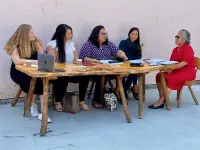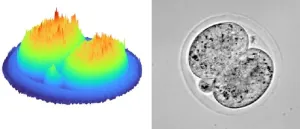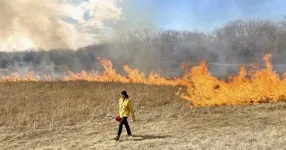(Press-News.org)
Heavy wildfire smoke drifting from Canada to U.S. cities hundreds of miles away is a stark reminder that no community is immune from climate change-fueled hazards. A Stanford-led study published recently in Environmental Research Letters provides a blueprint for empowering people in frontline communities – those that experience the “first and worst” consequences of climate change – to better understand and deal with wildfire smoke, extreme heat, and other hazards.
The research – done in four predominantly low-income, non-English-speaking San Francisco Bay Area communities – details ways for frontline communities to gather relevant data through surveys and instruments that monitor air quality, temperature, and participant sleep health, and how to improve outcomes through various interventions.
Below, lead author Natalie Herbert, senior author Gabrielle Wong-Parodi and coauthor Cade Cannedydiscuss the pilot study’s implications for policymaking, community-led science, and more. Herbert is a research scientist in the department of Earth system science at the Stanford Doerr School of Sustainability, Wong-Parodi is an assistant professor of Earth system science and a center fellow at the Stanford Woods Institute for the Environment. Cannedy is a program manager at Climate Resilient Communities and a Stanford graduate.
How have frontline communities suffered disproportionately from wildfire smoke, extreme heat, and other climate hazards?
Cannedy: In the communities we studied, housing is often very old or in poor condition. This allows smoke, heat, and other hazards to penetrate the home. Also, the impact of these events is often cumulative. For example, wildfire smoke can have greater consequences for your health if you already have asthma from growing up in a chronically pollution burdened community like those in our study area.
What are some key interventions frontline communities can employ to deal with wildfire smoke, extreme heat, and other climate hazards?
Herbert: We found communities are already acting to protect their health from climate hazards. For example, they’re wearing masks and staying inside during smoke and heat. Yet there are opportunities for more interventions that provide additional protection, whether from public health agencies, weatherization assistance programs, or funders who support the work of our community partners. For wildfire smoke, we want to increase the number of households with better weatherization to reduce infiltration, who have and use air cleaners with HEPA filters, and who wear better masks like N95s when they’re outside.
Why should policymakers care about your pilot study?
Herbert: We learned through our pilot that the programs policymakers might wish to deploy – such as improved improving weatherization and increasing access to air purifiers – could have unintended consequences for low-income communities. Weatherization in rental units could cause landlords to increase rents, and air purifiers won’t get used if people cannot afford the associated power bill. Renter protections and outreach from low-income home energy assistance programs can help.
Wong-Parodi: Our pilot highlights a key insight for policymakers: the reason many frontline communities are exposed to climate hazards stems from structural and institutional systems that create situations where some people have been marginalized and have fewer resources. It’s important to acknowledge we have little or no information about how people in these communities are exposed, or what they are thinking, doing, and feeling in response to these threats. This information is key to developing programs and policies that can best and appropriately meet the needs of frontline communities.
What are some of the important lessons learned from this pilot study, and how might they be incorporated into similar studies?
Wong-Parodi: Our pilot would not have been successful without our community partners and community ambassadors. They reached out to their networks of friends, families, and neighbors to enroll participants. They were key in helping us to explain the study and its benefits, as well as allaying concerns.
Cannedy: Many people want to make actions accessible, but often don’t consider the equity implications. For example, having people download a smartphone app might be a great, low cost intervention for users with a lot of resources and technical expertise. But for folks who are already experiencing the worst consequences of climate change, that might not be the best solution.
The study was funded by Stanford Impact Labs, the Stanford Center for Population Health Sciences, the United States Parcel Service Endowment Fund at Stanford, the US Environmental Protection Agency, and the National Science Foundation.
Additional coauthors affiliated with Stanford include Jinpu Cao, a PhD student in civil and environmental engineering; Stephanie Fischer, a PhD student in Earth system science; Sergio Sanchez Lopez, a PhD student in the Emmett Interdisciplinary Program in Environment and Resources (E-IPER);Derek Ouyang, a research manager in the Regulation, Evaluation, and Governance Lab of Stanford Law School; Jenny Suckale, an assistant professor of geophysics and center fellow, by courtesy, at the Stanford Woods Institute for the Environment; and Zhihao Zhang, a graduate student researcher in the department of energy science and engineering. Coauthors also include researchers from Climate Resilient Communities, RTI International, Sonoma Technology, and El Concilio of San Mateo County.
END
New drugs are often used not only for one disease (first approved indication) but also for other diseases (supplemental indications).
But a study published by The BMJ today finds that less than half of approved first indications for new drugs in the US and Europe between 2011 and 2020 add substantial therapeutic value over existing treatments and only around a third of supplemental approvals add substantial therapeutic value compared with first approvals.
The researchers argue that when first or supplemental indications do not offer added benefit over existing treatments, this information should be clearly communicated to patients and reflected in the price of ...
Lack of sleep lessens cognitive benefits of physical activity
Regular physical activity may protect against cognitive decline as we get older, but this protective effect may be diminished for people who are not getting enough sleep, according to a new study by UCL researchers.
The study, published in The Lancet Healthy Longevity, looked at cognitive function over 10 years in 8,958 people aged 50 and over in England. The research team investigated how different combinations of sleep and physical activity habits might affect people’s cognitive function over time.
They found that people who were more physically ...
Through the use of eHealth application ikHerstel, patients recover from major abdominal operations 30% faster than patients who do not use the app. That is the main conclusion of research led by Amsterdam UMC across eleven Dutch hospitals. The app aims to empower patients to feel more in control of their recovery process. The results were published today in Lancet Digital Health.
Patients are being discharged from the hospital quicker after treatment. Where patients used to receive care, information and support in the hospital for a number of days, they are now often ...
In a world-first, 3D holographic images of an embryo have been developed as part of a collaborative research project between the University of Adelaide and University of St Andrews. The images are created using miniscule amounts of light in a fraction of a second.
The team, led by Dr Kylie Dunning, Hospital Research Foundation fellow from the University of Adelaide’s Robinson Research Institute, and Professor Kishan Dholakia from the University of Adelaide and the University of St Andrews, developed an approach to create 3D holographic images of the pre-clinical model of an embryo at various stages ...
Encouraging adolescents to feel capable and purposeful – rather than just happy – could improve their academic results as well as their mental health, according to new research which recommends changing how wellbeing is supported in schools.
The University of Cambridge study, involving over 600 teenagers from seven English schools, examined two separate aspects of their wellbeing: life satisfaction and ‘eudaimonia’. While life satisfaction roughly equates to how happy a person is, eudaimonia refers to how well that person feels they are functioning. It incorporates feelings of competence, motivation and self-esteem.
Researchers ...
New insights explaining why some children have a longer remission than others after having cutting-edge CAR T-cell therapy for leukaemia have been revealed by researchers at UCL, Great Ormond Street Hospital, and the Wellcome Sanger Institute.
The collaborative research project, published today in Nature Medicine, combines expertise in novel immune therapy design and state-of-the-art computational analysis to identify a genetic signature of CAR T-cells that will be the most effective in the long term.
In recent years, CAR T-cells – genetically engineered ...
Using NASA's James Webb Space Telescope, a team of scientists led by University of Arizona astronomers has discovered a threadlike arrangement of 10 galaxies that existed just 830 million years after the Big Bang.
Lined up like pearls on an invisible string, the 3-million-light-year-long structure is anchored by a luminous quasar – a galaxy with an active, supermassive black hole at its core. The team believes the filament will eventually evolve into a massive cluster of galaxies, much like the well-known Coma Cluster in the "nearby" universe. The results are published in two papers in The Astrophysical Journal ...
LAWRENCE – A pyromaniac is someone unhealthily obsessed with the destructive power of fire. Melinda Adams instead is pulled toward the term pyromantic – a lover of “good fire” for the benefits it can bring to people, communities and the environment as a whole.
The Langston Hughes Assistant Professor in Indigenous Studies and Geography & Atmospheric Science at the University of Kansas, Adams extols the benefits of cultural or ceremonial fire in a new paper she has co-authored ...
“[...] we demonstrated that the combination of Nerofe and DOX exerts a synergistic effect during mCRC treatment [...]”
BUFFALO, NY- July 5, 2023 – A new research paper was published in Oncotarget's Volume 14 on July 1, 2023, entitled, “Transformation of immunosuppressive mtKRAS tumors into immunostimulatory tumors by Nerofe and Doxorubicin.”
Members of the rat sarcoma viral oncogene (RAS) subfamily KRAS are frequently mutated oncogenes in human cancers and have been identified ...
A new study conducted by researchers at Bar-Ilan University in Israel has shed light on the long-term impact of COVID-19 on the quality of life among different ethnic groups in the country. The study, part of a larger cohort project, highlights a significant discrepancy between Arabs and Druze, and Jews, with the two former groups experiencing a more pronounced decline in quality of life one year after infection.
In this cohort study, researchers regularly followed up with individuals who had been infected with the SARS-CoV-2 virus to assess various aspects of their health. The findings, published in the International ...





